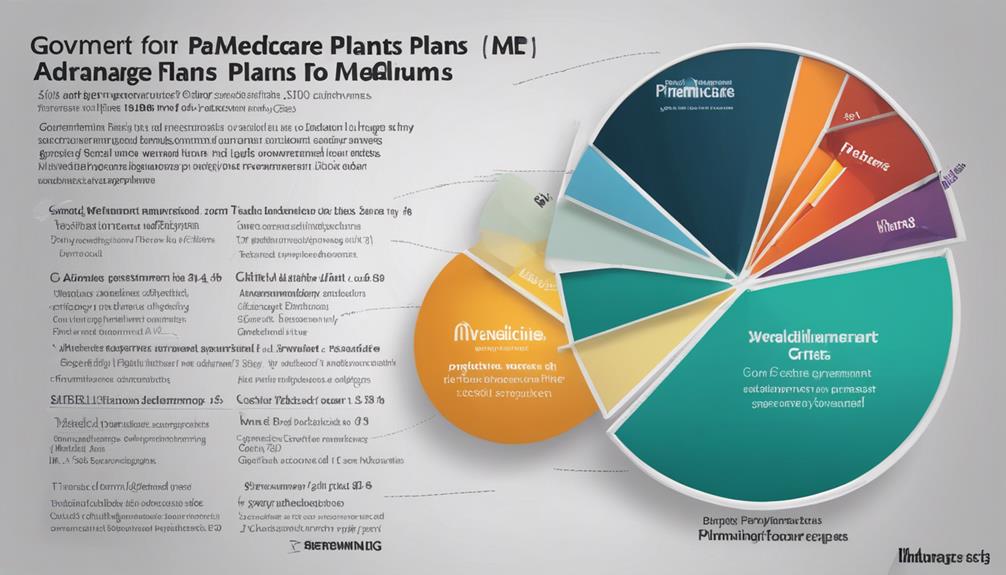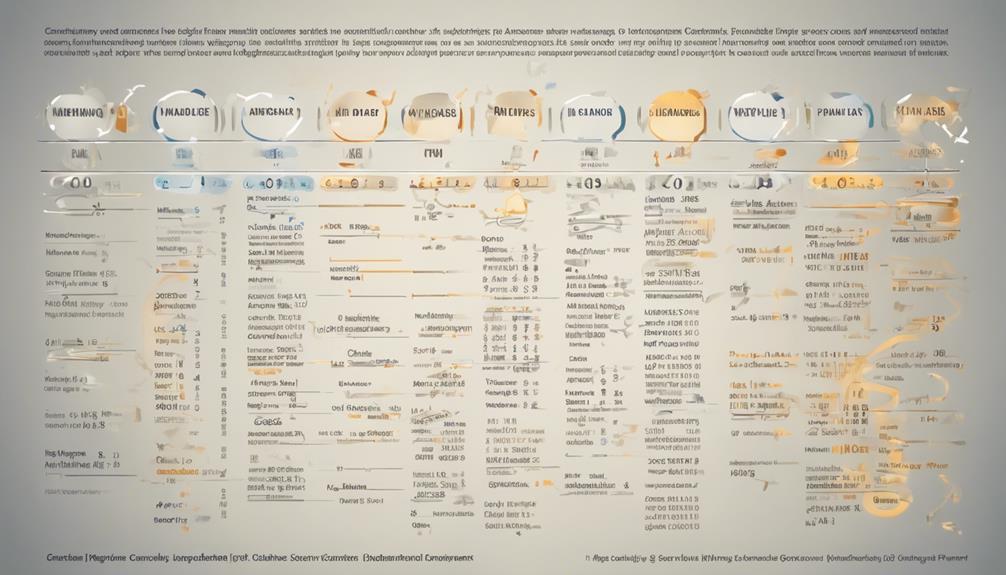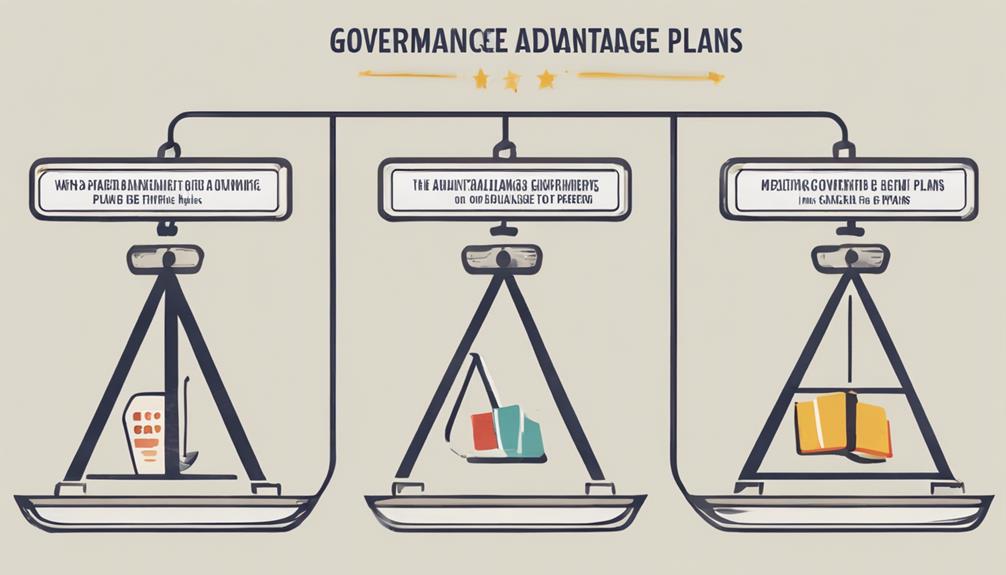Ever thought about the specific amount of money the government allocates for Medicare Advantage plans? This inquiry typically triggers interest and prompts a deeper dive into the complexities of healthcare funding.
Understanding the nuances of government payments to Medicare Advantage plans can shed light on the complexities of the system and the various factors that come into play.
As we explore this topic further, we will uncover the mechanisms behind these payments and the implications for both beneficiaries and the healthcare industry as a whole.
Key Takeaways
- Medicare Advantage funding based on fixed payments per beneficiary.
- Government payments calculated using bids, benchmarks, risk scores.
- Average payments exceed fee-for-service costs by 4%.
- Future trends suggest increased enrollment and federal spending.
Understanding Medicare Advantage Funding
Medicare Advantage funding operates on a system where fixed payments are allocated per beneficiary by the federal government, with adjustments based on submitted bids and predetermined benchmarks. These benchmarks are linked to the projected spending for a typical fee-for-service beneficiary. Plans that bid below the benchmark receive rebates, while payments are fine-tuned using risk scores and quality bonuses.
On average, Medicare Advantage payments surpass fee-for-service costs by around 4%. However, it's crucial to note that there are variations in benchmarks across different counties, impacting the overall funding received by Medicare Advantage plans. These county variations can influence the financial health and stability of the plans, as they must navigate the intricacies of the payment system to provide quality care while ensuring financial sustainability.
Understanding these nuances in Medicare Advantage payments is essential for optimizing the delivery of healthcare services to beneficiaries and fostering a robust healthcare system.
Government Payments for Medicare Advantage

Navigating the intricacies of government payments for Medicare Advantage plans involves understanding how fixed payments, bids, benchmarks, risk scores, and quality bonuses collectively shape the financial dynamics of the program. Medicare Advantage plans receive fixed payments from the government per beneficiary, with payments determined based on bids submitted by plans and predetermined benchmarks. Plans that bid below the benchmark receive a rebate, while adjustments are made using risk scores and quality bonuses. Benchmarks for Medicare Advantage payments are linked to projected spending for an average fee-for-service beneficiary. On average, government payments to Medicare Advantage plans surpass fee-for-service costs by around 4%. Understanding these mechanisms is crucial for stakeholders involved in the healthcare sector to comprehend the financial flows and incentives within the Medicare Advantage program.
| Aspect | Description |
|---|---|
| Fixed Payments | Government provides set payments per beneficiary. |
| Bids | Plans submit bids that influence payment calculations. |
| Benchmarks | Payments are based on predetermined benchmarks. |
| Risk Scores | Adjustments are made using risk scores to reflect the health status of beneficiaries. |
| Quality Bonuses | Plans may receive bonuses based on the quality of care provided. |
Factors Impacting Government Contributions
Analyzing various factors that influence government contributions to Medicare Advantage plans reveals the complex interplay between beneficiary demographics, health status, and plan performance in determining payment rates.
Medicare Advantage plans receive fixed payments from the government per beneficiary based on bids and benchmarks. Health status, demographics like age and gender, as well as income and resources, play a crucial role in impacting payment rates. These payments are risk-adjusted to account for the varying costs of care among different beneficiaries, ensuring that plans are adequately funded based on individual health needs. Additionally, Medicare Advantage plans must provide at least the same basic services as traditional Medicare, including Medicare Part B coverage details, which outline hospital outpatient care, doctor visits, and preventive services. Plans may also offer additional benefits, such as vision, dental, and prescription drug coverage, further enhancing their appeal to beneficiaries.
Risk adjustment models are utilized to calculate payment rates, considering the expected healthcare expenses of beneficiaries enrolled in these plans. Plans that bid below the benchmark may receive rebates, while high-performing plans can qualify for quality bonuses.
It's worth noting that the government typically pays Medicare Advantage plans more than traditional fee-for-service costs, with benchmarks in certain counties exceeding fee-for-service costs by specific percentages. Understanding these factors is essential for comprehending the nuances of government contributions to Medicare Advantage plans and ensuring their sustainability.
Calculating Medicare Advantage Plan Payments

To comprehend the methodology behind determining payments to Medicare Advantage plans, we need to understand how fixed payments per beneficiary, bid submissions, and benchmark comparisons form the basis of the calculation process.
- Fixed Payments: The government provides a set payment for each beneficiary enrolled in a Medicare Advantage plan, forming the foundation of the payment structure.
- Bid Submissions: Medicare Advantage plans submit bids detailing the costs of providing healthcare services. Plans bidding below the benchmark receive payments adjusted for quality bonuses and risk scores.
- Benchmark Comparisons: Benchmarks are established based on the projected spending for an average fee-for-service beneficiary. Plans that outperform the benchmark may receive quality bonuses, influencing the total payment from the government.
In essence, payments to Medicare Advantage plans are intricately tied to a combination of fixed government payments, bid submissions, benchmark comparisons, risk scores, and quality bonuses. Understanding this calculation process is essential for stakeholders in the healthcare industry to grasp how funds are allocated to support Medicare Advantage plans effectively.
Future Trends in Government Funding
Amidst the evolving landscape of healthcare funding, our attention is drawn to the future trends shaping government funding for Medicare Advantage plans. With Medicare Advantage enrollment projected to continue growing, federal spending on these plans is expected to surge by $316 billion from 2021 to 2029. This rise in spending is influenced by the enrollment of sicker and higher-cost beneficiaries in Medicare Advantage, raising concerns about equity between Medicare Advantage and traditional Medicare. Alternative projections for Medicare Advantage spending highlight potential savings and adjustments that could impact total Medicare costs. As we look ahead, it becomes evident that careful monitoring and potential reforms are crucial to address fiscal challenges and ensure effective management of government funding for Medicare Advantage plans.
| Key Points | Implications |
|---|---|
| Medicare Advantage enrollment | Continual growth necessitates sustainable funding solutions. |
| Federal spending | Requires efficient allocation to accommodate rising costs. |
| Equity concerns | Highlight the need for fair policies benefiting all Medicare beneficiaries. |
| Potential reforms | Essential for addressing fiscal challenges and ensuring long-term viability. |
Frequently Asked Questions
Does the Federal Government Pay for Medicare Advantage Plans?
Yes, the federal government pays for Medicare Advantage plans. These payments are made through fixed amounts per beneficiary, determined by bids from the plans and set benchmarks. Plans bidding below the benchmark receive rebates. Adjustments are made using risk scores and quality bonuses to ensure accurate funding.
Benchmarks are linked to projected spending for an average fee-for-service beneficiary, shaping the government's financial support for Medicare Advantage plans.
What Is the Biggest Disadvantage of Medicare Advantage?
The biggest disadvantage of Medicare Advantage is the restricted provider networks, limiting nationwide access compared to traditional Medicare.
Prior approval for treatments is often needed, unlike in traditional Medicare. Higher out-of-pocket costs and copayments can also be a drawback. Seeing specialists may require referrals, unlike in traditional Medicare.
Additionally, annual changes to covered services and networks may disrupt continuity of care. These factors collectively make Medicare Advantage less flexible than traditional Medicare.
Why Are People Leaving Medicare Advantage Plans?
We've seen people leave Medicare Advantage plans for various reasons. Changes in benefits, network coverage, or costs can trigger dissatisfaction. Some prefer traditional Medicare for broader access or fewer restrictions. Premiums, copayments, and out-of-pocket costs influence decisions. Moving or shifts in health needs also play a role. These factors collectively contribute to individuals exiting Medicare Advantage plans.
Factors such as changes in benefits, network coverage, costs, and personal preferences can lead individuals to reconsider their Medicare Advantage plans. Premiums, copayments, and out-of-pocket expenses along with changes in health conditions or geographic location can also impact the decision-making process. This complex interplay of factors drives individuals to transition from Medicare Advantage plans to traditional Medicare or other healthcare options.
What Is the Average Monthly Payment for a Medicare Advantage?
The average monthly payment for a Medicare Advantage plan typically hovers around $15, excluding the Medicare Part B premium. These plans offer Part D prescription drug coverage as well.
Government payments to Medicare Advantage plans are determined by various factors like risk scores, quality ratings, and benchmarks tied to traditional Medicare costs. In 2019, the government allocated $321 more per person for Medicare Advantage enrollees compared to those in traditional Medicare.
Conclusion
In conclusion, the government's payments to Medicare Advantage plans are influenced by various factors, including bids, benchmarks, risk scores, and quality bonuses.
While payments may exceed fee-for-service costs by a certain percentage, the funding structure is designed to provide quality care to beneficiaries while controlling costs.
As we look towards the future, it will be essential to monitor how these funding mechanisms evolve to ensure the sustainability and effectiveness of Medicare Advantage plans.









